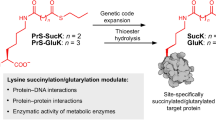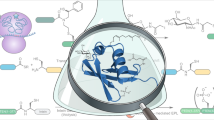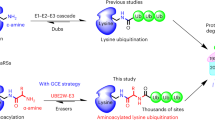Abstract
Of the 20 ribosomally coded amino acid residues, lysine is the most frequently post-translationally modified, which has important functional and regulatory consequences. Here we report the identification and verification of a previously unreported form of protein post-translational modification (PTM): lysine succinylation. The succinyllysine residue was initially identified by mass spectrometry and protein sequence alignment. The identified succinyllysine peptides derived from in vivo proteins were verified by western blot analysis, in vivo labeling with isotopic succinate, MS/MS and HPLC coelution of their synthetic counterparts. We further show that lysine succinylation is evolutionarily conserved and that this PTM responds to different physiological conditions. Our study also implies that succinyl-CoA might be a cofactor for lysine succinylation. Given the apparent high abundance of lysine succinylation and the significant structural changes induced by this PTM, it is expected that lysine succinylation has important cellular functions.
This is a preview of subscription content, access via your institution
Access options
Subscribe to this journal
Receive 12 print issues and online access
$259.00 per year
only $21.58 per issue
Buy this article
- Purchase on SpringerLink
- Instant access to full article PDF
Prices may be subject to local taxes which are calculated during checkout






Similar content being viewed by others
References
Walsh, C.T., Garneau-Tsodikova, S. & Gatto, G.J. Jr. Protein post-translational modifications: the chemistry of proteome diversifications. Angew. Chem. Int. Edn. Engl. 44, 7342–7372 (2005).
Witze, E.S., Old, W.M., Resing, K.A. & Ahn, N.G. Mapping protein post-translational modifications with mass spectrometry. Nat. Methods 4, 798–806 (2007).
Chen, Y. et al. Lysine propionylation and butyrylation are novel post-translational modifications in histones. Mol. Cell. Proteomics 6, 812–819 (2007).
Zhang, K., Chen, Y., Zhang, Z. & Zhao, Y. Identification and verification of lysine propionylation and butyrylation in yeast core histones using PTMap software. J. Proteome Res. 8, 900–906 (2009).
Hake, S.B., Xiao, A. & Allis, C.D. Linking the epigenetic 'language' of covalent histone modifications to cancer. Br. J. Cancer 96 (Suppl): R31–R39 (2007).
Martin, C. & Zhang, Y. The diverse functions of histone lysine methylation. Nat. Rev. Mol. Cell Biol. 6, 838–849 (2005).
Kruse, J.P. & Gu, W. Modes of p53 regulation. Cell 137, 609–622 (2009).
Hershko, A. & Ciechanover, A. The ubiquitin system. Annu. Rev. Biochem. 67, 425–479 (1998).
Sadygov, R.G., Cociorva, D. & Yates, J.R. III. Large-scale database searching using tandem mass spectra: looking up the answer in the back of the book. Nat. Methods 1, 195–202 (2004).
Bandeira, N., Tsur, D., Frank, A. & Pevzner, P.A. Protein identification by spectral networks analysis. Proc. Natl. Acad. Sci. USA 104, 6140–6145 (2007).
Chen, Y., Chen, W., Cobb, M.H. & Zhao, Y. PTMap—a sequence alignment software for unrestricted, accurate, and full-spectrum identification of post-translational modification sites. Proc. Natl. Acad. Sci. USA 106, 761–766 (2009).
Zhang, J. et al. Lysine acetylation is a highly abundant and evolutionarily conserved modification in Escherichia coli. Mol. Cell. Proteomics 8, 215–225 (2009).
Kim, S.C. et al. Substrate and functional diversity of lysine acetylation revealed by a proteomics survey. Mol. Cell 23, 607–618 (2006).
Cheng, Z. et al. Molecular characterization of propionyllysines in non-histone proteins. Mol. Cell. Proteomics 8, 45–52 (2009).
Allis, C.D., Chicoine, L.G., Richman, R. & Schulman, I.G. Deposition-related histone acetylation in micronuclei of conjugating Tetrahymena. Proc. Natl. Acad. Sci. USA 82, 8048–8052 (1985).
MacDonald, M.J. et al. Perspective: emerging evidence for signaling roles of mitochondrial anaplerotic products in insulin secretion. Am. J. Physiol. Endocrinol. Metab. 288, E1–E15 (2005).
Bergmeyer, H.U. Methods of Enzymatic Analysis, 624–627 (Academic Press, New York, 1974).
O'Shea, E.K., Klemm, J.D., Kim, P.S. & Alber, T. X-ray structure of the GCN4 leucine zipper, a two-stranded, parallel coiled coil. Science 254, 539–544 (1991).
Nelson, D.L. & Cox, M.M. Chapter 6. Enzymes. in Lehninger Principles of Biochemistry, 200–202 (W.H. Freeman and Company, New York, 2005).
Norris, K.L., Lee, J.Y. & Yao, T.P. Acetylation goes global: the emergence of acetylation biology. Sci. Signal. 2, pe76 (2009).
Berry, G.T. et al. Neonatal hypoglycaemia in severe succinyl-CoA: 3-oxoacid CoA-transferase deficiency. J. Inherit. Metab. Dis. 24, 587–595 (2001).
Bonnefont, J.P. et al. Alpha-ketoglutarate dehydrogenase deficiency presenting as congenital lactic acidosis. J. Pediatr. 121, 255–258 (1992).
Ostergaard, E. Disorders caused by deficiency of succinate-CoA ligase. J. Inherit. Metab. Dis. 31, 226–229 (2008).
Acknowledgements
We would like to thank Z. Cheng and Z. Wang for their assistance during the course of this study. This work was supported by US National Institutes of Health grants to Y.Z.
Author information
Authors and Affiliations
Contributions
Y.Z., M.T. and Z.X. designed the experiments. Y.Z. wrote the paper with the assistance from M.T., Z.Z. and Z.X. Z.Z. contributed to antibody purification and western blots of purified E. coli proteins; M.T. to HPLC-MS and data analysis; Z.X. to western blots, in vivo succinate labeling, mutagenesis, enzymatic assay, circular dichromism experiments, sequence alignment and structural analysis; L.D. to the chemical synthesis; Y.C. to PTMap analysis.
Corresponding author
Ethics declarations
Competing interests
The authors declare no competing financial interests.
Supplementary information
Supplementary Text and Figures
Supplementary Methods, Supplementary Figures 1–13, Supplementary Tables 1–3 and Supplementary Data Sets 1 & 2 (PDF 8882 kb)
Rights and permissions
About this article
Cite this article
Zhang, Z., Tan, M., Xie, Z. et al. Identification of lysine succinylation as a new post-translational modification. Nat Chem Biol 7, 58–63 (2011). https://doi.org/10.1038/nchembio.495
Received:
Accepted:
Published:
Issue Date:
DOI: https://doi.org/10.1038/nchembio.495
This article is cited by
-
SIRT5 promote malignant advancement of chordoma by regulating the desuccinylation of c-myc
BMC Cancer (2024)
-
Reversing the charge of lysine by genetic code expansion
Nature Chemistry (2024)
-
Deciphering functional roles of protein succinylation and glutarylation using genetic code expansion
Nature Chemistry (2024)
-
The emerging role of lysine succinylation in ovarian aging
Reproductive Biology and Endocrinology (2023)
-
Role of non-canonical post-translational modifications in gastrointestinal tumors
Cancer Cell International (2023)



